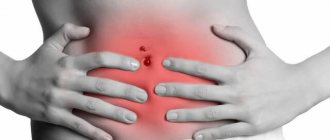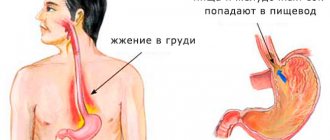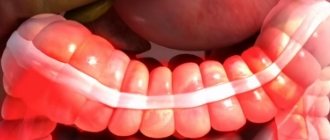The composition of stool can tell us about many things that happen in the body of adults. The consistency, smell and color of stool play a big role. Black diarrhea can occur in anyone. Diarrhea causes anxiety and discomfort. And dark brown or even black diarrhea in an adult makes you very wary, since this may indicate the presence of serious problems. The causes of black diarrhea can be completely harmless (yesterday I had to drink activated charcoal), but often black diarrhea appears due to dangerous factors, such as internal bleeding.
Problems in the body that cause black diarrhea
If an adult has permanent black diarrhea, then it is necessary to visit a doctor for diagnosis. The patient must tell doctors about the accompanying symptoms and undergo the necessary tests and tests. Only after making a diagnosis will the doctor be able to prescribe therapy.
The causes of black diarrhea can be different. The most common causes of black diarrhea include:
- internal bleeding;
- histoplasmosis (Darling pathology) is an infectious disease caused by fungi;
- the presence of neoplasms in the duodenum or stomach;
- hepatitis;
- polyps in the stomach, intestines;
- bleeding from the vessels of the esophagus;
- gastritis;
- Crohn's disease is a chronic inflammatory disease of the gastrointestinal tract;
- esophagitis.
People with a peptic ulcer should pay great attention to all changes in stool, especially if it turns black. This condition can occur due to erosion of the walls of the vessels of the stomach and duodenum.
The causes of black diarrhea in adults are not always the result of diseases. This condition is possible in the following cases:
- consumption of beets or other products that cause stool to turn black;
- strict diet;
- alcohol abuse;
- taking vitamins.
Taking certain medications, for example, activated carbon, De-Nol, Actiferrin, causes this symptom.
Causes
The occurrence of black diarrhea can be based on both physiological phenomena and pathology. Most often, symptoms appear due to:
- Consumption of certain foods
- Taking medications
- Bleeding from ulcers or erosions
- Inflammatory diseases of the digestive system
Next, we will look in more detail at the main causes of changes in stool, as well as the additional symptoms accompanying them.
Food
Changes in dietary patterns and consumption of foods unusual in the diet can trigger one-time diarrhea. This can be a manifestation of either ordinary indigestion or the first symptom of a food allergy (often rashes are added) or intolerance. In addition, some food itself can provide coloration to the discharge, for example:
- Red beetroot
- Blueberry
- Prunes
- Rowan chokeberry
- Blueberry
- Black licorice
- Coffee
- Blood sausage
- Meat with blood
Large amounts of coffee not only change the color, but can also cause diarrhea due to increased stimulation of peristalsis by caffeine.
If, after eliminating the above foods from the diet, the color of the stool does not change, then a full examination and diagnostic measures are necessary that will indicate the cause of the deterioration in well-being.
Alcohol and medications
Large amounts of alcohol can cause poisoning and cause diarrhea and bleeding. Particularly dangerous are low-quality drinks that use methyl alcohol, which is toxic to the liver and causes blindness.
Also, changes in stool can be caused by drugs, especially those containing bismuth and iron, which change color under the influence of digestive enzymes:
- De-Nol
- Ventrisol
- Bismofalk
- Vikalin
- Hemofer
- Totema
- Ferrum-Lek
- Aktiferrin
- Activated carbon
Normally, although the listed drugs color the stool black, they should not change its consistency.
Medicines containing acetylsalicylic acid (aspirin) reduce clotting and can cause bleeding in case of an existing stomach ulcer, and in case of long-term use, cause its occurrence.
Digestive diseases
Most often, black stool indicates internal gastrointestinal bleeding. Due to the presence of hemoglobin in red blood cells (the main component of which is iron), when it is exposed to hydrochloric acid of the stomach, oxidation occurs, which is manifested by black, often tarry, diarrhea.
The main diseases that can cause blood to fall into the digestive tract:
| Disease | Causes | Symptoms |
| 1. Erosive gastroduodenitis | Prolonged inflammation provokes the formation of erosions, which can periodically bleed. In this case, only the mucous membranes of the stomach and duodenum are affected. |
|
| 2. Peptic ulcer of the stomach and duodenum | Due to a violation of protective factors, a severe wall defect is formed, which affects the mucous and muscular layer of the organ and periodically bleeds. An ulcer can lead to perforation (a hole through the stomach) of the stomach or intestines. |
|
| 3. Mallory-Weiss syndrome | Small defects (tears) in the lining of the esophagus and upper stomach, which occur in people who drink significant quantities of alcohol or are prone to frequent gag reflex. |
|
| 4. Complicated esophagitis | Inflammation of the walls of the esophagus with the formation of areas of erosion on it, the appearance of perforations and bleeding with further formation of scars on the wall is possible. |
|
| 5. Varicose veins of the esophagus | Pathology of esophageal vessels, which leads to thinning of their walls and trauma. Often occurs against the background of portal hypertension. |
|
| 6. Intestinal diverticulosis | The formation of saccular protrusions that are prone to inflammation and rupture. |
|
| 7. Crohn's disease | An autoimmune disease that can affect any part of the digestive tract and cause inflammation and ulceration of the wall. |
|
| 8. Polyps | Benign growths on the inner wall of the stomach or intestines. |
|
| 9. Cancer | A malignant neoplasm that appears from the epithelial or glandular cells of the digestive organs and destroys nearby tissues. |
|
The appearance of loose stool, colored black, occurs only in case of exacerbation of the disease, while most of the time the main symptoms of the disease listed above come to the fore.
If there is blood in the stool, then a violation of the integrity of the mucous membranes occurred in the lower parts of the digestive system (most likely in the colon) and the enzymes did not have time to color the discharge black.
Self-diagnosis and accompanying symptoms
When black diarrhea occurs, you should not always sound the alarm. We need to think about what could cause black diarrhea. Often such an unpleasant phenomenon is accompanied by other symptoms, the presence of which should cause concern in an adult. Among these signs are:
- heat;
- chills;
- bloody discharge in feces;
- nausea, vomiting;
- pain in the abdomen;
- weakness;
- confusion
- mucous streaks in stool.
The temperature can reach 37.5 °C or higher. If vomiting occurs, the consistency of which is similar to coffee grounds, you must urgently call an ambulance. The same should be done if there is blood or mucus in the feces.
During pregnancy, women with loose stools of normal color already become a reason to contact a medical facility, and if it is black with the presence of water or red spots, then you should not hesitate to call a doctor.
There are some signs of internal bleeding, which should not be delayed in calling a medical team, these include:
- General weakness, excessive drowsiness. A person's vision may become dark.
- Dizziness, cold sweat, loss of coordination and even consciousness.
- Dry mouth. The patient is thirsty, and the desire to urinate disappears.
- Shortness of breath and vomiting with blood. Hands, feet and face may turn blue.
If you have these symptoms, you should not move or speak until medical professionals arrive. The patient must be laid down, the window opened and freed from clothing squeezing the chest.
Diagnostics
To determine the exact cause of the change in the color and character of the stool, a number of studies are necessary:
- Blood analysis.
Allows you to determine coagulability and find possible anemia (with prolonged hidden bleeding).
- Coprogram.
Studies the degree of digestion of food, together with bacterioscopy, allows you to confirm or refute an intestinal infection
- Ultrasound of the abdominal organs.
Visualizes possible inflammation, changes in organ size, heterogeneity of structure.
- X-ray with contrast.
Barium suspension helps determine the presence of bleeding ulcers, erosions, or even possible perforations.
- Fibrogastroduodenoscopy (FGDS).
Allows you to examine the esophagus, stomach and upper part of the duodenum, assess the condition of the mucous membranes and identify defects.
- Colonoscopy.
The most informative method for diagnosing intestinal diseases.
Even if loose black stools bothered you for a short time (1-2 days) and did not cause increased discomfort, it is better to undergo a comprehensive examination to make sure that the digestive organs are functioning. Preventive examinations to prevent pathologies should be carried out at least once a year.
Review of medications for black diarrhea
You can treat black diarrhea on your own if the diarrhea lasts no more than two days and does not have accompanying symptoms.
Effective and safe remedies for the treatment of black diarrhea are:
- Regidron. It is taken throughout the day. One sachet of the drug is diluted in a liter of water. The medicine helps restore the balance of fluid and salt.
- Polysorb. It is effective for intestinal infections, hepatitis, and poisoning. However, you should know that the drug should not be taken in case of bleeding in the gastrointestinal tract.
- Smecta. This sorbent relieves diarrhea and reduces signs of intoxication.
- Enterol. Contains bifidobacteria, which help normalize intestinal function and eliminate diarrhea.
If a person has black or dark brown diarrhea for several days, he is prescribed a stool test. After diagnosis, the following medications may be prescribed:
- Sulfanalamides. Used in cases of infection (Fthalazol).
- Nitrofurans (Furazolidone).
- Antibiotics (Levomycetin, Tetracycline).
- Enterosorbents. Help remove toxins from the body (activated carbon or Smecta).
- Antimicrobial drugs. These include Stopdiar, Enterofuril and Intetrix.
- Antispasmodics. Used in the presence of pain and bloating (Papaverine, No-shpa).
- Antiviral agents. Restores the balance of salt and water. Regidron is most often used.
For black diarrhea with water discharge, antibiotics are used in very rare cases.
Treatment of black diarrhea should be comprehensive. In addition to the correct selection of medications, the patient must follow a diet. Doctors also recommend some folk remedies to achieve faster results of therapy.
Causes of black diarrhea
In a laboratory assessment of stool, the structure, color, and smell can be used to preliminarily judge the nature of the stool disorder. Although these indicators are individual and are largely determined by the diet, regimen, and the effect of medications that the patient takes, there are general signs of normal stool:
1 its shape resembles a cylindrical roller;
2 in consistency it is moderately compacted, without areas of loosening and flocculent inclusions, without foreign impurities;
3 it has a specific fecal smell, without a sour and putrid stench;
4 color varies in brownish shades.
Each person has his own individual dietary preferences, which are reflected in the consistency and color of his stool. For example, meat eaters have darker stool compared to vegetarians. The density of stool is affected by the amount of liquid remaining in it after nutrients are absorbed. Causes of dark or almost black diarrhea can be:
1 physiological;
2 pathological.
The liquefaction of feces and changes in their color may be the result of a sudden change in diet, mild food poisoning, or dysfunction of the digestive system. Diarrhea with dark-colored feces sometimes appears during drug therapy, as a side effect of the action of individual components of drugs that negatively affect the digestive process. But very black liquid stool during diarrhea may also indicate a serious condition of the patient due to the appearance of internal bleeding. And in such cases, it is necessary to hospitalize the patient and provide him with urgent medical care.
Traditional methods of treatment
Folk medicine for black diarrhea has been used since ancient times. They are used as an addition to the main therapy and help speed up the process of restoration of the gastrointestinal tract at home. Various herbs, decoctions, teas and tinctures help eliminate signs of black diarrhea and restore the balance of salt and water. Among these means, the most popular are:
- Peppercorns. This product, used as a seasoning, has long been used to relieve diarrhea. Adults are recommended to eat 10–13 peas to restore stool consistency. Five to six pieces will be enough for the child. If you are very upset, it is better to do this before bed. In the morning, all signs of diarrhea will disappear. There is no need to chew the pepper. It should be swallowed like a tablet with liquid.
- Oak bark. It is used for prolonged diarrhea. To prepare the decoction you will need 300 ml of water and a pinch of crushed bark. The ingredients are mixed and put on fire. After boiling, the mixture remains on the gas for about ten minutes. The container is not covered with a lid. It is necessary for approximately 100 ml of liquid to evaporate. You should take this decoction three times a day, one spoon.
- Bird cherry. Both the bark and berries of the plant are used in equal proportions. A spoonful of these mixed ingredients is poured with a glass of boiling water. The liquid is boiled in a water bath for 20 minutes. You should drink half a glass twice a day.
- Potato starch. A spoonful of this ingredient is mixed in a glass of unboiled water and drunk in one gulp. This recipe doesn't work for everyone. Reviews about its use are completely different: for some it became much easier, for others the product did not help at all. If after the first use there is no effect, then you should not take this home remedy anymore.
- Pomegranate peels. Two tablespoons of dried and crushed peels are poured into a glass of boiling water, boiled for half an hour and filtered. You only need to drink liquid, do this before meals, 300 ml.
- Sage. 50 grams of dry leaves of the plant are poured with 0.5 liters of boiling water. Infuse the product for an hour, strain, and then add 500 grams of red wine (preferably dry). Every two hours you should drink 150 ml of this product.
- Rowan juice. This remedy only helps if you use natural juice. You need to drink one glass (50 grams) twice a day. After drinking juice, you should not eat for half an hour.
- Walnut partitions. They are taken in the amount of one spoon and poured with boiling water (0.5 l). The product is infused for 20 minutes, then filtered. You should drink this liquid in the morning in an amount of 150 ml.
In order to combat dehydration caused by prolonged black diarrhea, it is recommended to make the following solution: mix 2 grams of baking soda, 10 grams of salt and twice as much sugar in one liter of boiled water. This drink is drunk every half hour, a quarter of a glass.
Black loose stools in a child, causes
Black diarrhea in a child undoubtedly causes concern for parents. If the baby is not capricious, sleeps normally, is active, and is active in games, perhaps this is a temporary phenomenon associated with the introduction of new complementary foods and taking certain medications. The stool will return to normal in 2-3 days if you adjust your diet.
You cannot do without a pediatrician if your baby has vomiting, high fever, and the stool has become watery with mucous lumps (signs of an intestinal infection). All symptoms and signs of black stool during diarrhea should be described to the doctor; a referral to gastroenterology or the infectious diseases department may be needed.
Nutrition for stool restoration
If dark brown or black diarrhea occurs, you should follow a special diet. The principles of nutrition are to avoid eating:
- fatty, smoked, fried foods;
- carbonated drinks, alcohol and coffee;
- dairy products;
- raw vegetables, fruits;
- semi-finished products;
- sweets;
- sauces, ketchups, mayonnaise.
In case of severe distress, it is recommended not to eat anything other than boiled foods. Try to get by with just rice and eggs. You can also add chicken fillet and crackers to your diet, prepared yourself from a white loaf. Dishes are allowed to be heavily salted, as this will help retain fluid in the body and prevent dehydration. It is recommended to eat soups with weak chicken or beef broth.
Porridge should be cooked only in water and boiled thoroughly so as not to irritate the intestines. As drinks, you can use not only weak teas, but also non-concentrated compotes made from dried fruits. At the same time, they should contain a minimum of sugar.
When to Seek Help from a Doctor
Not everyone knows what to do if the diarrhea has become very dark, almost black. Don't panic. If there are no serious problems with the gastrointestinal tract, you need to adjust your diet, stop drinking alcohol, and your stool will return to normal within 2-3 days.
People who have a history of chronic diseases of the gastrointestinal tract should immediately be puzzled by the question of why the stool turns dark during diarrhea, since this may indicate internal bleeding. Alarming symptoms in the form of constant nausea, severe vomiting, tachycardia, dizziness are a reason to call the emergency room.
If there is no improvement within 2 days, but the patient’s condition is satisfactory, he needs to contact a local physician, and for a detailed diagnosis, a gastroenterologist or infectious disease specialist.
Diagnostic measures
If you experience diarrhea with black mucus, you should immediately consult a doctor. He will listen carefully to the symptoms, study the outpatient card and prescribe an examination.
To clarify the cause of the pathology, the following procedures are prescribed:
- FGDS;
- colonoscopy;
- blood analysis;
- stool analysis.
What do these medical studies provide?
FGDS
FGDS is esophagogastroduodenoscopy. A procedure in which a person swallows a thin tube with a miniature video camera attached to the end. The research method allows you to see exactly what caused the internal bleeding.
Using FGDS, you can examine the condition of the stomach, esophagus and duodenum. Although the procedure is unpleasant, it gives the doctor complete information about the state of the gastrointestinal tract.
We recommend: Is it possible for diarrhea to occur with appendicitis as a symptom of the disease?
Colonoscopy
This is a procedure in which a probe is inserted through the anus and makes it possible to examine the lower gastrointestinal tract.
Conducting laboratory tests
Laboratory analysis allows the doctor to see whether there are intestinal infections in the body and at what level of hemoglobin. These data allow you to get a complete picture of the state of the body and not make mistakes when making a diagnosis.











